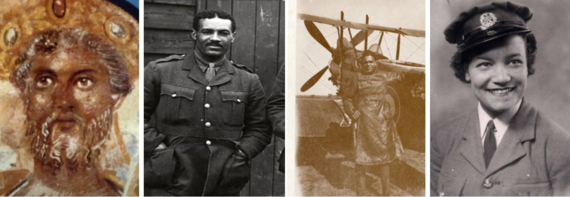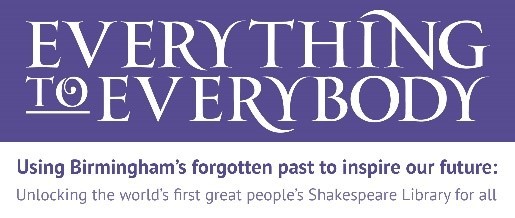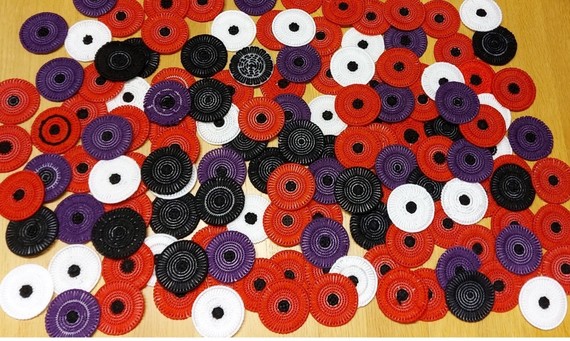|
April 2021
This month we have a bumper edition to keep you going over the Easter period! Including features on our wonderful project 'From City of Empire to City of Diversity: A Visual Journey", an Easter-themed jigsaw, an update on the Children's Library Writing Black History workshops, a place-names of Birmingham word search puzzle, a wonderful piece about community art... the Jewellery Quarter Poppy Project in which hundreds of tapestry poppies have been made (what do the 4 colours of the poppies mean?!)... and... as its Shakespeare’s birthday on 23 April, a piece about the release of a specially commissioned music video!
![Montage of black & white and sepia studio and outside portrait/group photographs showcasing images from the Dyche Collection [MS 2912].](https://content.govdelivery.com/attachments/fancy_images/UKBCC/2021/03/4309858/montage-of-black-white-and-sepia-studio-and-outside_original.jpg) A small selection of photographs showcasing images from the Dyche Collection [MS 2912].
Funding was recently awarded by the National Lottery Heritage Fund to the Library of Birmingham and Sampad to document the collection, and curate two photographic exhibitions which will utilise materials from the Dyche Collection along with other photographic collections held in the Archives, alongside a community engagement programme to coincide with the 2022 Commonwealth Games taking place in the city. But what do we know about it?
The Collection (MS 2912)
The collection consists of approximately 10,000 images (both negatives and prints), business records including a small number of day books (listing the orders taken and sittings made on particular days), ephemera including studio signs, calling cards and trade catalogues. A number of pieces of specialist photographic equipment are included, such as a camera, hand painted backdrops, studio props and a home built bromide printer, used to mass produce postcards. No indexes to help identify sitters in the photographs survive.
Please see our online catalogue if you are interested in the trade catalogues we hold for Dyche.
The collection was primarily an Image Bank when it arrived in the library in the same cardboard boxes the photographs had been stored in at the studio. Library staff were able to attend to the photographs and prepare for storage but there was unfortunately no capacity to catalogue or index the collection.
History of the Company
Ernest Dyche (1887-1973) and his son, Ernest Malcolm (1921-1990) known as Malcolm had two studios in the city, the first, ‘The Palace Studio, Bordesley’ (in close proximity to The Palace Theatre) was based at 33 Coventry Road, opened in 1905, and operated until c. 1937.
The second studio at 354 Moseley Road, Balsall Heath which is the premises Pete James visited, opened c. 1913. Ernest was self-taught and looking at the full range of photographs in the collection, what comes across is his entrepreneurial drive, his diversification into different areas, be it wedding photos, postcards, celebrity snaps and venturing outside of the studio setting to take photographs of social gatherings. This may have been reflective of how he was valued as a photographer both technically and for his marketing skills as the work would have been commission-based.
Find out more about this wonderful collection in the extended article on our BlogSpot and about our Community Archivist's take on starting an Archives project in lockdown!
Paul Taylor, Archives & Collections Co-ordinator.
This month's online jigsaw puzzle features an Easter greetings card produced by Eyre & Spottiswoode of London. It's from the Geoff Parker Scrapbook, the wonderful Parker Collection. in the Library of Birmingham's Early and Fine Printing Collection! [Ref. 698217]. Find out more about the wonderful greeting cards in our collections on our website!
During January and February, the Children's Library at the Library of Birmingham ran a series of creative writing workshops for teenagers about Black Britons. Over the course of 4 weeks, we wrote opinion pieces and poetry, letters and dystopian stories. we discussed the pros and cons of emigrating to Mars, the importance of diversity in the books we read and the politics that shape our lives. Each week before we focussed on a particular Black Briton, we looked at the Britons who came before them, the Britons who paved the way for their achievements.
Activists
 Claudia Jones, Olive Morris, Diane Abbott and Baroness Lawrence of Clarendon.
Before we talked about the work of the activist Baroness Lawrence of Clarendon and her fight for her murdered son Stephen Lawrence, we remembered Claudia Jones, founder of the first commercial Black Newspaper, and London's Notting Hill Carnival. we remembered Olive Morris, a member of the British Black Panther Movement and a founding member of the Brixton Black Women's Group and we remember Diane Abbott, the first black woman to become an MP and the first black person to stand at the dispatch box at Prime Minister's question Time.
Fighters
 Septimus Severus, Walter Tull, William Robinson Clarke, and Lilian Bader.
Our final workshop was about Acting Corporal Lilian Bader. We started by looking at Emperor Septimus Severus and the North African Roman Garrison at Hadrian's Wall. We then went on to talk about Walter Tull one of the first black officers in the British Army, and William Robinson Clarke one of the first Black Volunteers to qualify as a pilot and fly biplanes over the Western Front.
Lilian Bader was born in Toxteth, Liverpool in 1918. Her Mum was Irish and her Dad Barbadian. She and her two brothers were orphaned when she was 9. The rest of her childhood was spent in a convent. When Bader left the convent at 20, she had a tough time finding a job she wanted because of her colour and eventually went into domestic service.
When World War II broke out, she joined the Navy, Army and Air Force Institutes (NAAFI), a civilian organisation which ran canteens and shops to support members of the Armed Forces. She was forced to leave the NAAFI when an official from London found out that her father was Black.
By 1941 things had changed, not only had the RAF dropped their colour bar, but they had also started allowing women to sign up. Bader joined the Women's Auxiliary Air Force in 1941 and became one of the first black women to join the British armed forces.
Bader was one of the first women to train as an Instrument repairer and despite her brother being killed in action just before she started her training she passed 'First Class'. She was then posted to RAF Shawbury where her job was to check and repair the instruments in the aircraft. She did well in her post and was soon a Leading Aircraftwoman.
Bader appears in a clip from 'Pilots of the Caribbean' (1990). Part of the clip shows an extract from a debate on whether you would fight for a country which discriminates against you. We discussed this and linked it to the current debate about whether there is institutional racism in the Police.
After a balanced debate with a range of views, our participants were given the brief ' A close relative has emailed you to say how disappointed they are that you have signed up. What do you reply?
You can see one of the emails from Iona 14, on our blog, Words and Music.
Michèle Barzey, Children's Library, Library of Birmingham.
Can you spot theses place-names in the puzzle below? Why not have a go at working out the meaning of the place-names too?! If you need a little help - take a look at the fantastic Key to English Place-Names website where you can look up names, elements and meanings! Not all of them will be there (it's a work in progress), but you'll be able to trace some of the elements! For example, Birmingham is "either, 'homestead/village of Beorma's people' or 'homestead/village connected with Beorma'."

 Like to the Lark studio image. Photographer: Simon Peter King.
The ‘Everything to Everybody’ Project will be celebrating Shakespeare’s birthday on 23 April with the release of a specially commissioned birthday music video and lots of special birthday messages from partners online!
The project is an ambitious celebration of one of the UK’s most important cultural assets: the Birmingham Shakespeare Memorial Library – the first great Shakespeare library in the world, held at the Library of Birmingham, and the only great Shakespeare collection which belongs to all the people of a city.
The Ex Cathedra Education Team have created the Like to the Lark music and video. The song was written by Dan Ludford-Thomas and it will be released as Birmingham’s birthday present to Shakespeare on 23 April 2021. Inspired by the Bard, the Shakespeare Memorial Library at the Library of Birmingham and the progressive values of George Dawson and the ‘Everything to Everybody’ Project, Like to the Lark is a song of freedom and solidarity, which really resonates now as the project seeks to unlock the Shakespeare Collection and society begins to free itself from the restrictions of national lockdown.
Going forward, building on this year’s greetings, the ‘Everything to Everybody’ Project hopes to establish a distinctive ‘Birmingham Birthday’ for Shakespeare – one which celebrates Birmingham’s distinctively democratic Shakespeare heritage and the diverse character of the city today.
A collaboration between the University of Birmingham and Birmingham City Council, with funding contributed by National Lottery Heritage Fund and History West Midlands ‘Everything to Everybody’ will give this uniquely democratic Shakespeare heritage back to people and communities across Birmingham.
To achieve this, ‘Everything to Everybody’ is working in conjunction with anchor institutions and grassroots organisations across Birmingham supporting, inspiring and championing projects such as Like to the Lark.
Tune into the Everything to Everybody Project’s social media platforms on 23 April to watch and listen to Like to the Lark for yourself (note: it won't be live until the 23rd): www.everythingtoeverybody.bham.ac.uk
 |
|
Twitter @E2EShakespeare
Facebook @e2eshakespeare
Instagram @e2eshakespeare
You Tube
|
 The Jewellery Quarter Cemeteries Project is a 2-year programme of restoration works in Key Hill and Warstone Lane cemeteries, funded in partnership with National Lottery Heritage Fund, Birmingham City Council and Jewellery Quarter Development Trust. Alongside the restoration there is a programme of events and activities to encourage more people to engage with, visit and learn about the cemeteries, both their history and value as green spaces.
During lockdown, the cemeteries have been a lifeline for the local community as places to take daily walks, but restrictions mean that many people cannot visit and so many events have changed to accommodate this. One recent example is the JQ Poppy Project which was run in partnership with Woolly Mammoth Stitchworks and funded by the Birmingham Municipal Charity. In order to commemorate not only those who died in WWI and WWII who are remembered on gravestones and war memorials in the JQ, but also those of all nations killed in all conflict, we have been stitching hundreds of tapestry poppies to make a community artwork, which will be displayed at Remembrance events throughout the project and for many years to come. The poppy stitching kits were sent to participants by post and nearly all of them have now found their way home! The kits included a postcard explaining the meanings of the 4 colours of poppy.
 Nearly 150 members of the public have stitched a poppy for us and we are now just waiting for our school groups to return their poppies, as their stitching sessions were delayed due to remote learning, and then artist Tina Francis will put them all together! We originally intended to debut the artwork in April but this will not be possible now due to COVID restrictions. We plan to have the artwork on display in the cemeteries on 4th and 5th June in Warstone Lane Cemetery (COVID roadmap permitting). Project staff and volunteers will be on hand throughout both days to chat about the project and hand out self-guided war graves trails for those who wish to explore further.
We are so grateful to everyone who took part in the project, it was amazing to have people from across Birmingham, the Midlands and beyond, come together to stitch and remember those who have been lost – spending collectively over 200 hours on the project! We know from the feedback comments that the participants really valued the fantastic kits created by Woolly Mammoth and being part of the project. One stitcher said ‘It's been nice to think that my small contribution will be part of a tribute that is so significant and a cause close to my heart’ and many people commented that it was a fun or therapeutic exercise for them, one stitcher said ‘I enjoyed sewing the poppy as staying at home because of coronavirus it is a pleasure to feel I have done something positive.’
Although our project is now drawing to a close, Woolly Mammoth Stitchworks are involved with other projects all the time, so there are often opportunities to get involved. Check their website for the latest projects.
We hope to see many of our stitchers and other interested people in person in June, but for those who can’t attend, you can find out more about the cemeteries from the comfort of your own home on our website.
Josie Wall, Jewellery Quarter Cemeteries Project.
We hope you've enjoyed this update - it's production is a collaboration between the Archives, Community Libraries, the Library of Birmingham, Library Services at Home, the Mobile Library, and the Prison Library! Our aim is to share Birmingham’s history, archives, and community heritage activities, showcasing our city’s unique and irreplaceable archival collections, keeping you updated about projects and events you can get involved with! In every issue there will be a range of articles and fun quiz activities to involve you with our unique and irreplaceable collections!
Explore the
Archives catalogue here
|
Find out more about the Archives here
|
Explore the Library catalogue here
|
If you no longer wish to receive this newsletter please use the 'unsubscribe' here.
|